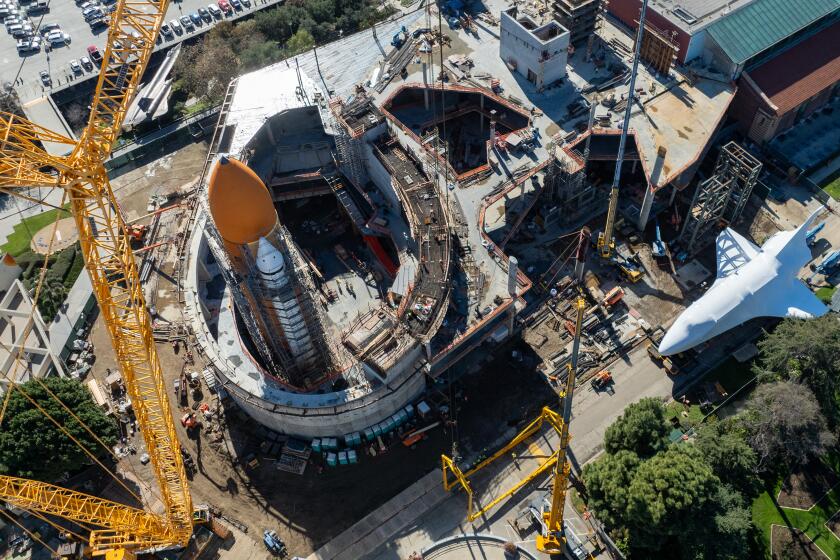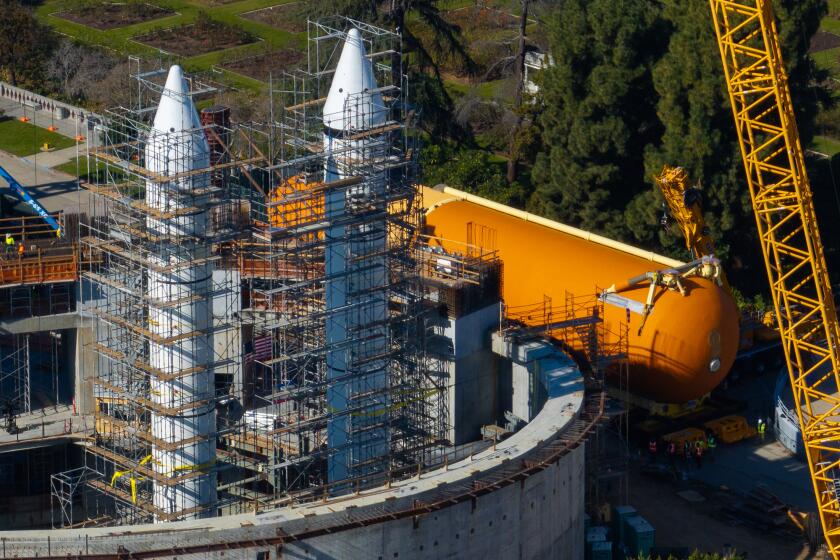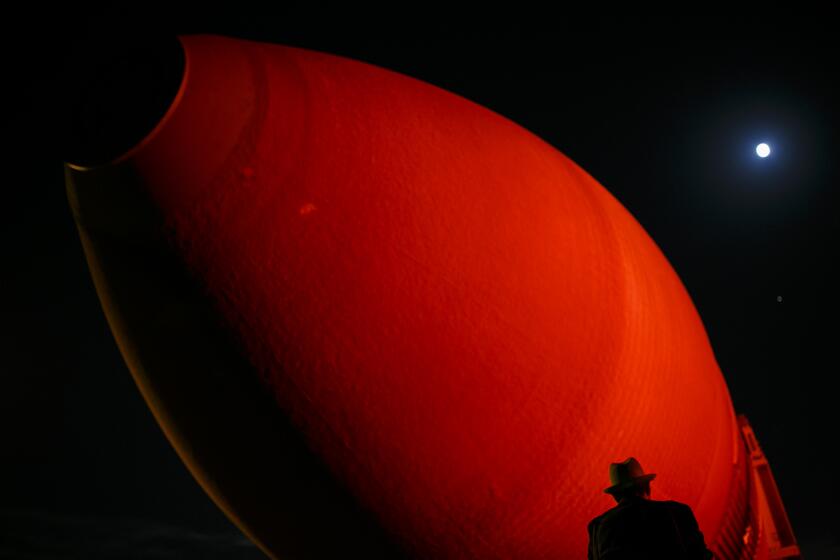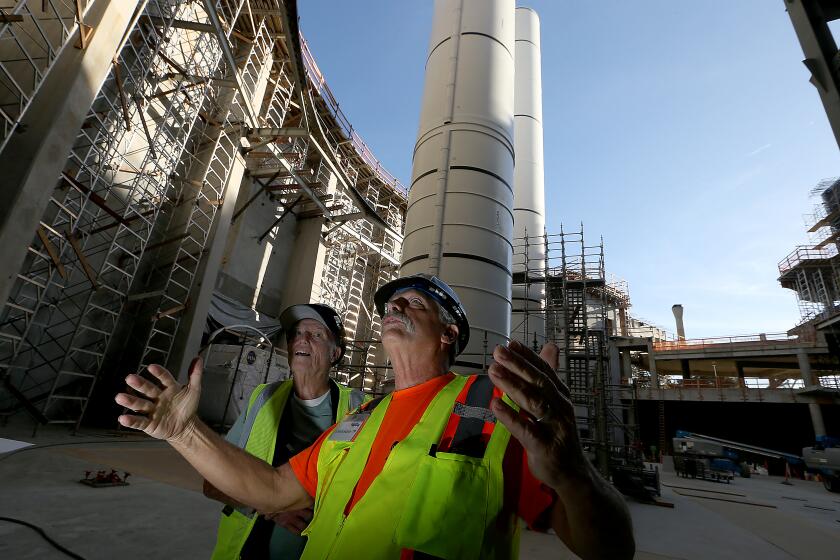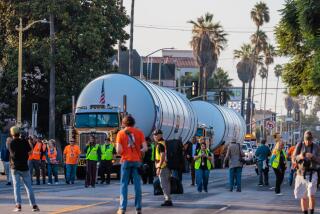
- Share via
The final journey for the last space shuttle ever built is complete.
Set against the black backdrop of the night sky, a crane hoisted a white shrink-wrapped Endeavour 200 feet overhead before gently lowering it to its ultimate resting space, outside the California Science Center, on Tuesday morning.
Endeavour was stacked vertically and affixed to an already positioned external tank and two solid rocket boosters, the last leg of its 19-year career, which included 25 space voyages.
The orbiter’s last mission, however, is not to touch the stars, but to inspire the next generation of space explorers, serving as the pièce de résistance of the still-under-construction Samuel Oschin Air and Space Center.

“It’s been a very quick process tonight, and I think we’ve exceeded expectations,” said Jeffrey Rudolph, president of the California Science Center. “We were fortunate with good weather and not too much wind.”
The full-stack launch position of Endeavour is rare; no other space shuttle is displayed in such a way. In fact, for the last 11 years, Endeavour has rested in a horizontal position inside the California Science Center, awaiting the move to its permanent home.
Barring high winds or other bad weather, the orbiter will be lifted by two cranes late Monday in a move that could take up to 10 hours to complete.
The orbiter’s placement marks the first time a shuttle designed for space was assembled vertically outside of a NASA or Air Force facility.
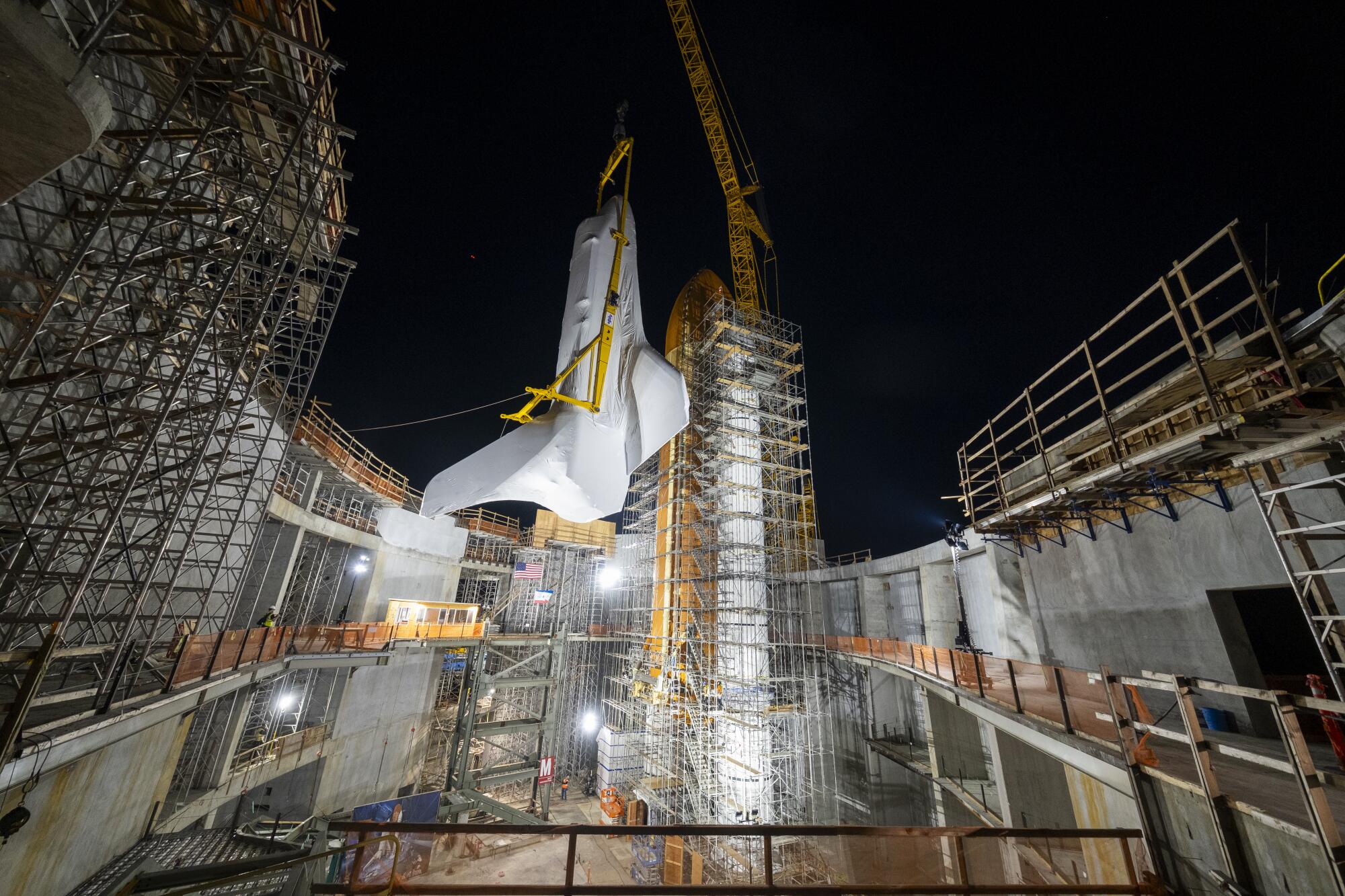
Shortly after 9:30 p.m. Monday, as crowds watched from State Drive, crews used an 11-story crane to hoist Endeavour’s tail while a larger, 40-story crawler crane used a sling to carefully lift its nose.
The move started 30 minutes earlier than anticipated, with officials saying calmer-than-expected winds prompted them to act. The installation was livestreamed.
When the shuttle was pointing upward, the smaller of the cranes was removed. The larger one then began lowering the orbiter just after midnight.
The positioning had to be precise. The shuttle’s nose was raised 200 feet into the night sky so that the rudder could clear 80 feet of space. Endeavour was then turned 17 degrees clockwise to provide adequate clearance for its 78-foot wingspan before being carefully lowered, according to Larry Clark, a retired space shuttle engineer who worked 44 years at the Kennedy Space Center in Florida.
Endeavour’s slow descent was “terrifying” for astronaut Garrett Reisman, who pointed at the far tip of the rudder as it came within 20 feet of the second-level platform.
The move was delayed by winds, but crews eventually raised the massive tank Friday at the California Science Center before nearly finishing Saturday.
“They really had to thread the needle,” said Reisman, who flew on three space shuttles, including Endeavour on his first mission in 2008. “Fortunately, we only have to do this once.”
A professor of astronautics practice at USC, Reisman said the stacked formation offers a true vantage point of the orbiter.
“People always said it was either much bigger or much smaller than expected, and it’s because in previous viewings, it was right on top of you,” Reisman said. “Here, you can get a feel of the scale, when you’re standing right here next to the external tank and rockets.”
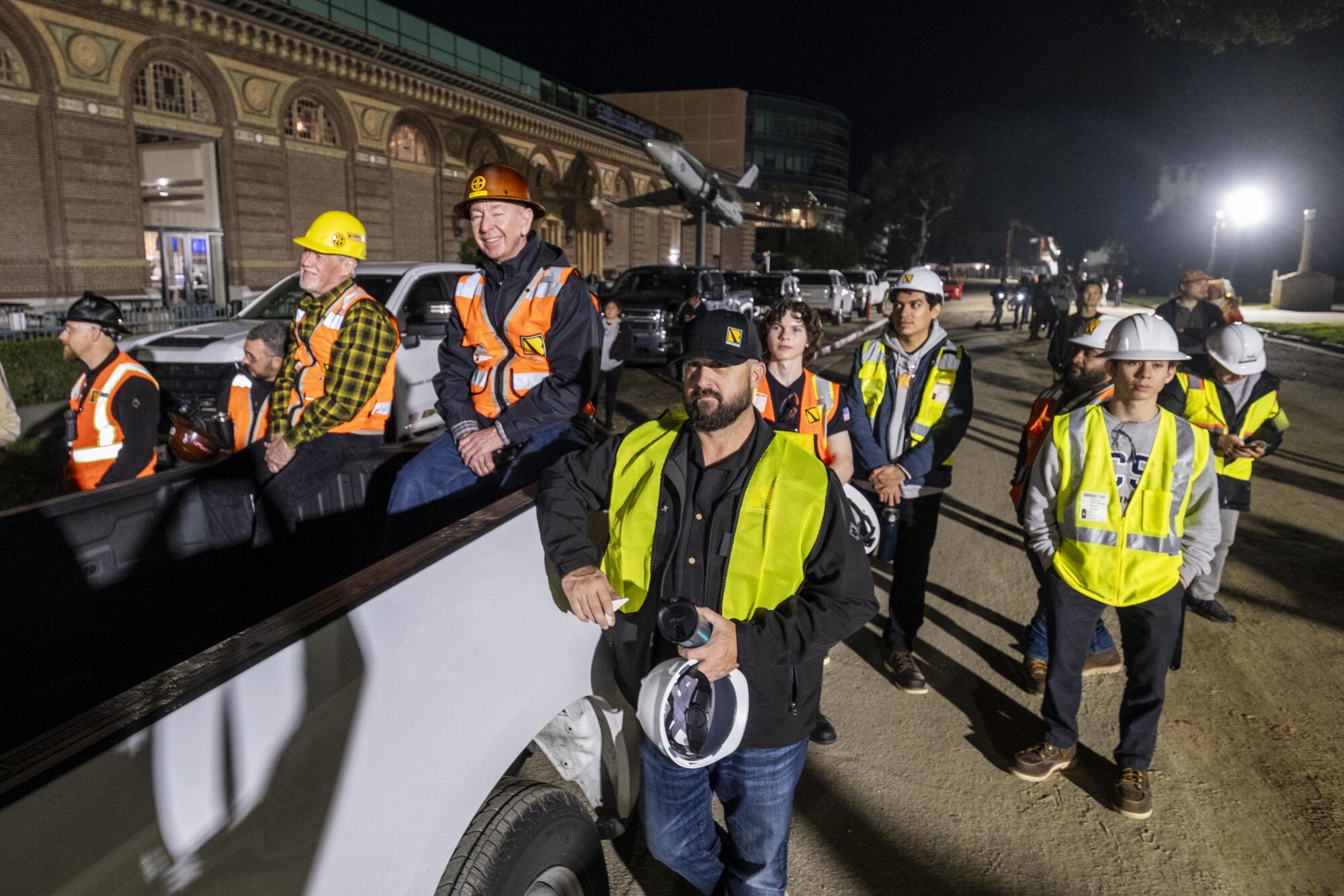
Workers and engineers tossed electric cables and ropes from scaffolding as the final few feet of movement were handled by a hydraulic Hydra-Set mounted control box operator.
“Once the crane gets the orbiter within about 4 inches of where it needs to be, [the operator] will take over lowering the rest of the way with micro-inch capability,” Clark said.
At long last, the final journey of the last space shuttle ever built, Endeavour, and its giant orange external tank are expected to begin this month — the capstone to a historic journey to an ambitious museum exhibit in Los Angeles.
The first part of the move, which began Monday night and finished Tuesday morning, was known as the “soft mate” and consists of the orbiter’s hoisting and lowering near the external fuel tank and rockets.
The second part will be the “capture” — the process of attaching Endeavour to the 15-story external fuel tank dubbed ET-94. The giant orange tube is the last such tank in existence.
The “hard mate” may happen as early as Tuesday evening, but it could take a couple of days, Rudolph said. During that time, the crane’s sling will be removed, the space shuttle will stand without assistance and all of its parts will be bolted into place.
“Where Endeavour is positioned now is basically where it’s going to be,” Rudolph said.
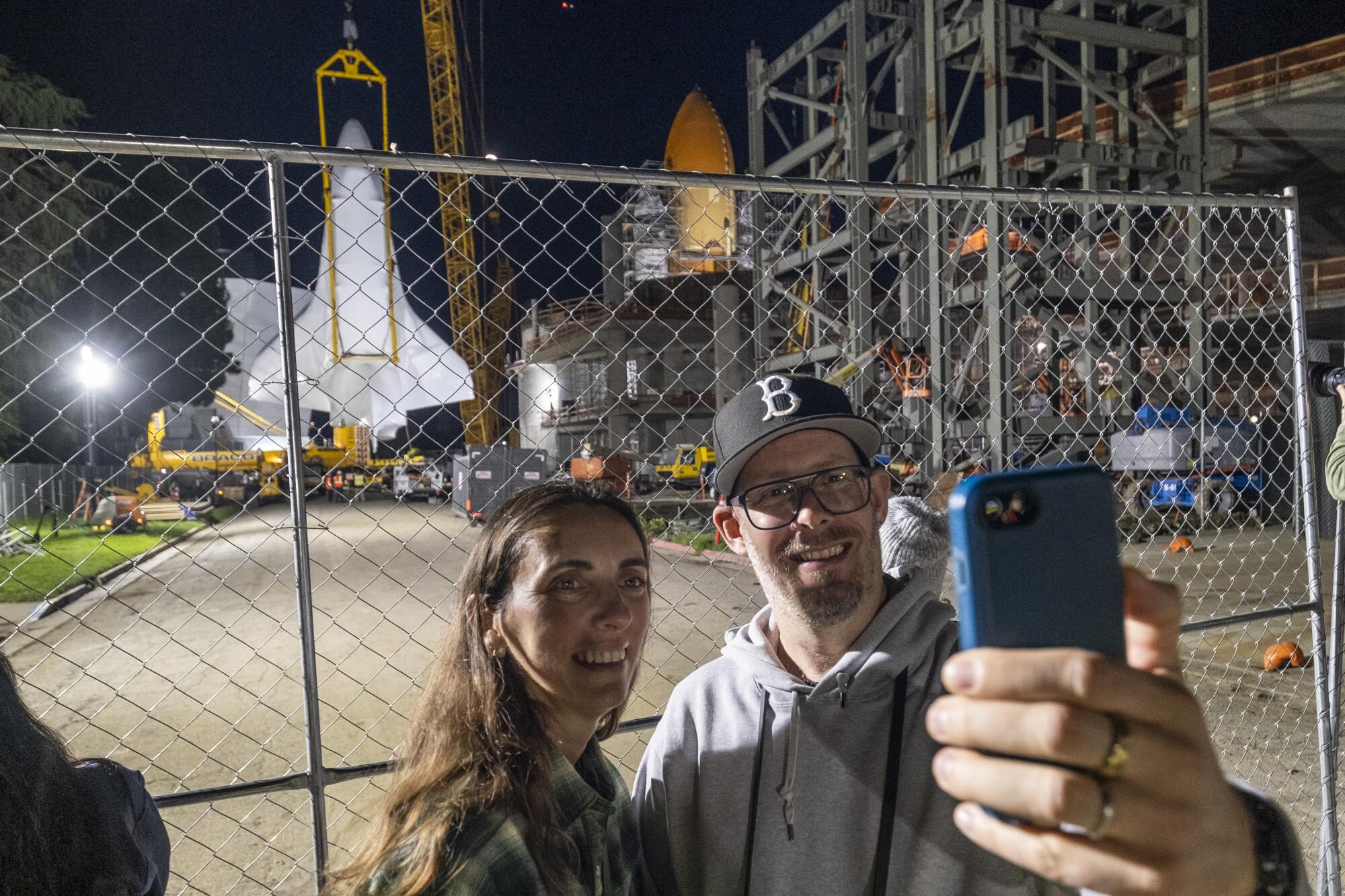
Engineers shrink-wrapped the shuttle a week earlier, “using a great big heat gun fueled by a propane tank,” according to Clark. The orbiter was enclosed to protect it from work site pollution and the elements. The covering is not expected to be removed until construction of the 20-story Oschin Center, which will be built around the full-stack display, is complete.
It will be a few years before the shuttle will be accessible to the public as the space museum and its other exhibits are constructed.
Crews successfully lifted into place giant rockets at the California Science Center, the first large components installed at the future home of the space shuttle Endeavour.
The stacking process at the Los Angeles site presented challenges to engineers who were used to multiple cranes and platforms used at the Kennedy Space Center.
Scaffolding was constructed, removed and adjusted throughout various parts of the positioning.
The rockets, external tank and orbiter were installed over a seven-month period, with the twin 149-feet solid rocket boosters assembled between July and November, the external tank in early January and the orbiter on Tuesday.
It took about six hours to install the rockets, nearly the same time needed to complete Endeavor’s soft mate.
The external fuel tank move, however, was delayed by winds and needed 14 hours over two days to complete.
The final move comes more than a decade after Endeavour rolled through the streets of Los Angeles. The shuttle received rock star treatment upon its arrival, with people lining the streets to watch the craft move from Los Angeles International Airport to the California Science Center in October 2012.
More to Read
Sign up for Essential California
The most important California stories and recommendations in your inbox every morning.
You may occasionally receive promotional content from the Los Angeles Times.
